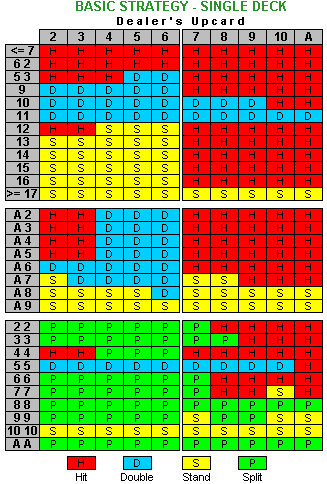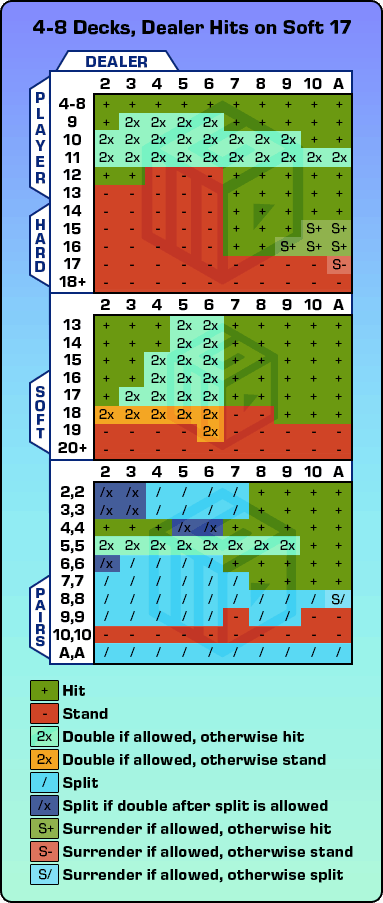When Does Dealer Have To Hit In Blackjack
In order to understand how the best strategy is computed, lets have a look at the Blackjack rules. Blackjack is played with 1 to 9 decks of 52 cards each. The values of the cards correspond to their numerical value from 2-10. All face cards (Jack, Queen, King) count 10 and the Ace either 1 or 11, as the holders desires. A score with an ace valued as 11 is named soft-hand. A soft-hand score of 17 is denoted as 7/17.
The color of the cards does not have any effect.

This bonus was later removed but the blackjack name persevered. In virtually all variations of blackjack the dealer does not have any decisions to make. The most common forms of blackjack require that the dealer hits up to and including 16 and sticks on 17 (both soft and hard). If the dealer does not deal himself an ace as a face-up card, then players are asked if they would like to “hit” or “stand”. To hit is to ask for another card, to stand is to pass. If you choose to hit and then receive a card that puts you over the value of 21, you’ve busted and are now out of that round. All decisions have been made and all that remains is to determine whether or not you have beaten the dealer. The Only Reason For Hitting Your Hand. There is only one reason to take a hit at the blackjack table. You always hit your hand in an effort to improve the hand. If you hit the hand for any other reason, you are doomed to failure. Hitting soft 17 gives the dealer the chance to make the 18, 19, 20 and 21 hands that can win on their own against a player pat hand. This comes into play most often when the dealer’s face up card is an Ace and basic strategy players hit until they have 17 or better. The house will win when players bust, regardless of the final dealer hand. If you have Eleven: Double if the Dealer has 2 to 10, Hit if the Dealer has Ace. If you have Twelve: Hit if the Dealer has 2 or 3, Stand if the Dealer has 4 to 6, otherwise Hit. If you have 13- 16: Stand if the Dealer has 2 to 6, otherwise, Hit. If you have 17 – 21: Always Stand. How to Play Soft Hands: A soft hand is when one of your.
The goal of the game is to reach a score (=sum of the cards) as high as possible but not more than 21. A Blackjack (Ace and a card whose value is 10) beats all other combination of cards. If the final sum is higher than the sum of the dealer, the player gets a play-off of 1:1 of his initial stake. If the players combination is Blackjack, the play-off is 3:2 of the initial stake. If the sum of the dealer is higher, the player loses his bet. If the sum is equal, then nobody wins. If the player holds a score of 22 or more, he busted and thus he loses his bet immediately. If the dealer busts, the players wins independently of his final score.

Blackjack can be played from one to seven players against one dealer. The dealer shuffles the cards. Now all the players must place their bets. Then each player and the dealer receives one card. The cards all lie face up. Thereafter the player receive a second card. The player now can continue to buy further cards, one by one, until he believes that he is near enough to 21. If the player believes to have reached a score high enough he must signalize the dealer to stay, which means not to ask for any further card.
Doubling down
The player has some more possibility's other than buy and stay. If he reached a score of nine, ten or eleven with his first two cards, he can double his bet. However if he does so, he will be dealt only one more card.
Splitting
If the first two cards are of the same value, the player has the possibility to split his hand, which means that each of the cards are used to start with a separate bet. For each split hand, an additional bet equal to the first is required. There is one exception: If the player splits two Aces, he receives only one more card and in such a case a score of 21 is not considered as Blackjack.
Dealers turn
Once the last player has decided to stay with his score, the dealer starts to draw a second card. If his result is reaching a score of 17 or more, he will deal himself no further cards. If the dealer has a score of 16 or less, he must draw until he has reached 17 or more. If the dealer exceeds 21, he busts. This is the basic knowledge You have: The dealer can not split nor double; he must play according to strict rules: Dealer must stand on all 17. That's the players advantage! On the other side, if both the player and the dealer busts, these scores are not considered as equal and the player looses his stake. That's the dealers advantage!
How to compute the correct strategy
The analyst sees the shoe as black box which computes him a probability for drawing a card of a certain value. Say we have 6 decks of 52 cards, so the probability of drawing an Ace is 6*4/6*52 = 24/312 = 7.7%. The probability of drawing a second Ace without reshuffle is 23/311 = 7.4% and so on. As the game goes on without reshuffle, the probabilities to draw certain cards will raise or decline, depending on which cards have gone in the past. From our point of view the shoe behaves like a wheel of fortune with varying distances between the nails.
The first thing to do, is to calculate the probabilities of the dealers last hand. This computation is straight forward as the dealer has no way of doing any decision. So it is quit easy to find out the probabilities of his final score.
The next thing is to find out the probabilities of what would be if ... . If the players score is 16, what's the probability of achieving 17, 18, 19, 20, 21 or busting. Probabilities also have to be calculated for splitting and doubling.
Because the player knows the dealers first hand before deciding what to do, he can compare the probabilities of the dealers last hand against the probabilities of possible final scores for each intermediate score he has. With this comparison, winning expectations can be calculated, gaining information about the best playing strategy.
Blackjack Dealer Rules
Knowing the best playing strategy and knowing the probabilities for each final score, the dealer and the player will reach, the total expectation can be calculated. The total expectation is the magic number playing Blackjack. If it is below zero the player has to place minimum bets as with this card distribution he will lose on the long term. If however the total expectation is above zero (unfortunately thats quite rare) the player has to place high bets.


Interpret the strategy tables
For each decision a player can do the best strategy can be computed. There are 20 possible conditions where the player has to take decisions. These are:
- Buy or stay if the score is 12, 13, 14, 15, 16, 7/17 or 8/18.
- Double or buy, if the sum of the first two cards is 9, 10 or 11.
- Split, buy or stay, if the first two cards have the same value.
All these decisions depend upon the dealers first card, making a total of 200. There are some fundamental rules, which never change and must always be obeyed:
- Alway buy if the score is below 12.
- Always buy if the score is below or equal to 7/17. With a soft hand You can't bust, so there is no reason to stay if the score is 17 or less.
- Never buy if the score is 17 or higher.
- Never split 5-5. A score of 10 is a good point to start with, so use it.
- Never split X-X. A score of 20 is too good, to take any further risks.
- Never ever double a Blackjack.
For other decisions consult the expectation and probability tables computed on the Blackjack strategy pages.
Stakes height

When Does Dealer Have To Hit In Blackjack Machine
The stake has to be placed before the player can see the dealers first card. So during that decision, very little information is available. The only information the player here, is the total expectation for the current card distribution in the shoe. If this is above zero, he shall place high bets.
I like to assume that anyone reading one of my posts is starting at zero. I’m not doing exactly that here, because I’m not explaining in detail all the rules of casino blackjack.
But I do want to draw the distinction between hard hands and soft hands.
Blackjack is a simple comparing game where the player and dealer each start with a two-card hand. The one with the higher total points for their hand wins the bet, but only if they keep theirtotal to 21 or below. A total of 22 or higher is an automatic loss.
The cards have points based on their rank. The numbered cards have the same number of points as their numbers: 2, 3, 4, 5, 6, 7, 8, 9, and 10. The face cards (jack, queen, and king) are alsoworth 10 points each.
The only exception is the ace. No one would blame you for thinking that an ace is worth 1 point. It is, in fact, in many situations, worth a single point.
But it’s also worth 11 points.
When you have a hand with no aces in it, you have a hard total. This means that the total is what the total is.
For example, if you have a jack and a 3, you have a hard total of 13. There’s no wiggle room there. That’s the total.
But if you have an ace and a 3, you have a soft total. That’s because the ace counts as 11, but if you get a card that would otherwise give you a total of 22, you can count it as a 1 instead.
With an ace and a 3, you have a soft 14. If you hit that hand and get a 10, you have a hard 14. (Any hand where the ace must be considered 1 point to avoid busting is also considered a hardhand.)
The strategy for a player with a soft hand as opposed to a hard hand is significantly different. Since you have that added layer of protection from busting, the right move is often to play a softtotal more aggressively.
But when we talk about a soft 17 “rule” in blackjack, we’re talking about how the dealer plays his hand.